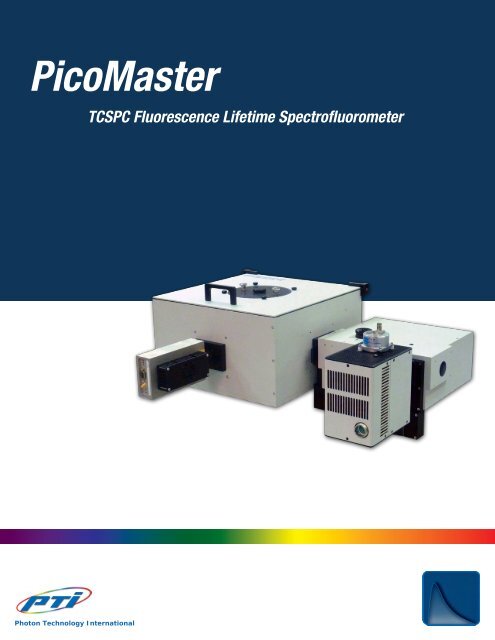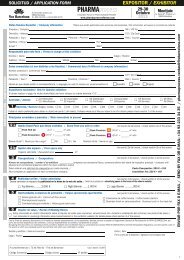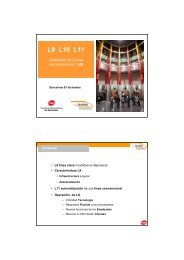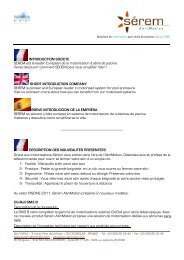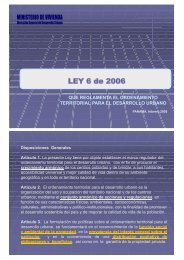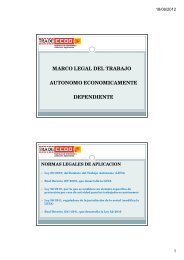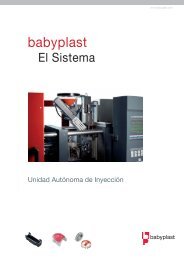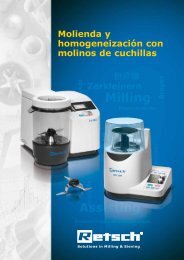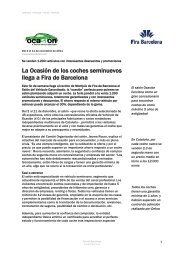PicoMaster
PicoMaster
PicoMaster
Create successful ePaper yourself
Turn your PDF publications into a flip-book with our unique Google optimized e-Paper software.
<strong>PicoMaster</strong><br />
Photon Technology International<br />
TCSPC Fluorescence Lifetime Spectrofluorometer
<strong>PicoMaster</strong><br />
Fluorescence Lifetime Spectrometer<br />
PTI has been manufacturing modular fluorescence systems for nearly<br />
three decades. Fluorescence lifetime instrumentation has always been<br />
one of the main product lines of our company. In fact, PTI was awarded<br />
a prestigious R&D 100 Award for developing a new stroboscopic<br />
lifetime technique back in 1989. Our team of scientists and engineers<br />
understands that diverse applications require different experimental<br />
approaches and therefore we develop and offer different techniques<br />
that can meet these challenges.<br />
The <strong>PicoMaster</strong> line represents modular fluorescence lifetime<br />
systems based on the Time Correlated Single Photon Counting<br />
(TCSPC) technique. These instruments can meet the strictest<br />
demands with regard to the lifetime range, from single picoseconds<br />
Fluorescence Lifetime Measurements<br />
Applications of time-resolved fluorescence (TRF) have been<br />
growing very rapidly in recent years. They encompass very diverse<br />
disciplines, ranging from chemistry and biology to various materials<br />
science disciplines such as nanotechnology, semiconductors,<br />
crystals, glasses and ceramics. These applications are based on the<br />
fluorescence lifetime, which is the average time a molecule spends<br />
in the excited state before emitting a photon and returning to the<br />
ground state.<br />
The fluorescence lifetime provides complementary information to<br />
the commonly used steady state measurements, as it adds the ability<br />
to resolve molecular dynamic events and multiple components of<br />
a system, which are averaged in the steady state experiment. The<br />
lifetime not only reflects intrinsic properties of the excited molecule,<br />
but is also affected strongly by properties of the environment and by<br />
various interactions with surrounding molecules.<br />
For example, conformational changes in proteins, nucleic acids or<br />
other macromolecules can be monitored and detected by measuring<br />
the emission decay of the probe molecule. Distances between two<br />
chromophore groups of a macromolecule can be determined by<br />
studying the fluorescence resonance energy transfer (FRET), which<br />
reduces the lifetime of the donor molecule. Polarity, viscosity of the<br />
environment, ion transport, and local electric field will be “imprinted”<br />
in the lifetime of the excited molecule. The presence of impurity or a<br />
dopant will affect the luminescence decay of a crystal.<br />
Emission decays often show more than one lifetime and in some cases<br />
are described by even more complex kinetic behavior. PTI systems<br />
include a complete software package, which contains analysis<br />
modules for virtually any time-resolved application. Another<br />
important technique is time-resolved emission anisotropy, which<br />
is an emission decay measurement with polarized light. The temporal<br />
behavior of anisotropy depends on rotational freedom of the emitting<br />
molecule and thus can be used to determine microviscosity of a<br />
membrane, the size of a protein, to follow folding and unfolding of a<br />
protein or to monitor curing processes of polymers.<br />
to seconds, and provide the highest dynamic range of at least 5<br />
orders of magnitude. There are many types of light sources that the<br />
<strong>PicoMaster</strong> can use, such as pulsed LEDs, laser diodes, and modelocked<br />
lasers pumping OPO or dye lasers and higher harmonics<br />
generators. With its Multi-Channel Scaling (MCS) capability, even<br />
low repetition lasers, such as nitrogen/dye or Q-switched can be<br />
used for longer fluorescence or phosphorescence lifetimes. A variety<br />
of detectors are available that can cover different spectral ranges,<br />
from UV to NIR, making the instruments suitable for very diverse<br />
applications. And being modular, they can be combined with the<br />
steady state fluorometer, phosphorescence system or utilized in<br />
microscopy measurements.<br />
Protein decay, ex=295 nm, em=320, 340, 400 nm<br />
Fluorescence decays of bovine serum albumin protein measured with<br />
<strong>PicoMaster</strong> 1 (295 nm LED and PMD-2 fast PMT detector). A 3-exponential<br />
fitting function required to obtain adequate fits (pre-exponential factors in<br />
parentheses):<br />
320 nm: 0.3ns (0.43), 2.6ns (0.23) and 6.5ns (0.34)<br />
340 nm: 0.3ns (0.20), 2.8ns (0.22) and 6.5ns (0.58)<br />
420 nm: 0.4ns (0.34), 4.6ns (0.38) and 7.9ns (0.28)<br />
Fluorescence decays shown in the adjacent figure illustrate a complex<br />
decay of intrinsic tryptophan (Trp) in bovine serum albumin (BSA)<br />
protein measured across the emission spectrum. The analysis reveals<br />
3 lifetime components pointing to heterogeneous environment and<br />
conformational diversity of the protein imprinted on the fluorescence<br />
decay of polarity sensitive Trp. Such detailed information is not<br />
revealed in the steady state measurement alone.
The Advantages of TCSPC<br />
•<br />
•<br />
•<br />
Signal Statistics - Due to a low probability of photon detection<br />
in a single excitation event, the standard deviation of the<br />
measured intensity is governed by Poisson statistics. Therefore,<br />
the S/N is well-defined and statistical data analysis involving<br />
numerical reconvolution and fitting of various decay models can<br />
be performed in a rigorous and reliable way.<br />
High Dynamic Range - Photons can be counted practically<br />
indefinitely, so fluorescence decays can be obtained and analyzed<br />
over many orders of magnitude (typically 4 to 5), which enhances<br />
the precision of the lifetime determination, especially important<br />
for complex decays.<br />
Short Lifetimes - Due to availability of lasers with ultra-short<br />
pulses (fs-ps), low-jitter multi-channel plate (MCP) detectors and<br />
single photon avalanche photodiodes (SPAD), lifetimes of a few<br />
picoseconds can in principle be measured.<br />
Modern TCSPC Technology<br />
The TCSPC systems offered by PTI represent the most modern state<br />
of the art technology.<br />
Gone are the days when the TCSPC electronics was mounted in a<br />
huge, floor standing NIM-BIN rack that housed a collection of standalone<br />
modules like the time-to-amplitude converter (TAC), two<br />
constant fraction discriminators (CFD), time calibrator, coaxial cablebased<br />
delay line, a web of interconnecting cables and an assortment<br />
of knobs and toggle-switches.<br />
In the modern PTI offering, all these components, including the<br />
TAC, two CFDs, a fast analog-to-digital converter (ADC) and the<br />
memory buffer are all integrated in a single PCI board. The board also<br />
provides two 12 V outputs to power the PMT and an optional trigger<br />
photodiode. The only connections to the board are the START and<br />
Max Count Rate: 10 MHz<br />
Repetition Rates: 0 to 200 MHz<br />
Frequency Divider: 1-2-4<br />
Dead Time: 100 ns<br />
Min Time/Channel: 813 fs<br />
Max Time Channels/Curve: 4096<br />
Measurement Times Down to: 0.1 ms<br />
TAC Range: 50 ns to 5 µs<br />
Biased TAC Amplifier Gain: 1 to 15<br />
CFD Threshold (Photon Channel): -20 to -500 mV<br />
CFD Threshold (Sync Channel): -20 to -500 mV<br />
Sync Delay: Electronic, automatically calculated and<br />
applied for the selected TAC time range<br />
MCS min time/channel: 25 ns<br />
•<br />
•<br />
•<br />
<strong>PicoMaster</strong><br />
Lifetimes in NIR - Due to availability of photon counting PMT<br />
and SPAD detectors with near-infrared sensitivity, the TCSPC is<br />
the best choice to measure pico and nanosecond lifetimes in NIR.<br />
Time Domain Technique - Fluorescence intensity is measured<br />
directly as a function of time, which makes it more intuitive to<br />
interpret and easy to follow the kinetic mechanism of a system<br />
during the measurement.<br />
Immune to Intensity Fluctuations - Since no more than a<br />
single photon is counted as a result of a single flash, the intensity<br />
vs. time histogram is not affected by pulse-to-pulse intensity<br />
fluctuations of the light source.<br />
STOP pulses and an optional external TTL trigger. All the board<br />
functions are conveniently controlled from Felix GX software – a<br />
comprehensive software platform that operates all PTI instruments<br />
and data analysis.<br />
The TCSPC board also has a Multi-Channel Scaling (MCS) function<br />
incorporated. That makes the TCSPC system really versatile and<br />
capable of measuring longer fluorescence and phosphorescence<br />
lifetimes, from a few tens of nanoseconds to seconds. With the MCS<br />
operation the user can utilize low repetition rate sources, such as<br />
xenon flash lamps as well as nitrogen and Q-switched lasers.<br />
PTI TCSPC systems offer femtosecond time resolution, MHz count<br />
rates and are excellent choices for the most demanding applications.<br />
Old TCSPC electronics<br />
Modern TCSPC board
<strong>PicoMaster</strong><br />
TCSPC Technique<br />
The TCSPC is the time-domain technique. Like the other PTI lifetime<br />
technique, the Strobe, it utilizes pulsed light sources (lasers, LEDs and<br />
old-fashioned ns flash lamps). It also measures the same experimental<br />
functions as the Strobe, i.e. the fluorescence decay and the IRF. Its<br />
detection, however, is based on a different principle.<br />
The block diagram shows the principle of the TCSPC operation.<br />
The pulse generator triggers the light source and also outputs a sync<br />
START pulse which triggers the detection electronics. Alternatively,<br />
for the ultimate in temporal resolution, the START pulse can be<br />
generated by a fast photodiode in front of the excitation source.<br />
The START pulse after being fed through a Constant Fraction<br />
Discriminator (CFD) starts the Time-to-Amplitude Converter (TAC),<br />
the key element of the technique. After being triggered, the TAC<br />
starts a voltage ramp, which is linear in time.<br />
In the mean time, the sample has been excited and has emitted<br />
fluorescence photons. When the PMT detects the 1st photon, a short<br />
pulse is created at the output of the PMT. The photoelectron pulses<br />
from the PMT show considerable pulse-to-pulse amplitude variations<br />
and are therefore fed through another CFD, which eliminates the<br />
time jitter caused by the amplitude spread. The signal then enters the<br />
TAC as a STOP pulse and stops the voltage ramp.<br />
The voltage value (equivalent to the time difference between the<br />
start and stop pulses) is read by an analog-to-digital converter (ADC),<br />
converted to a time channel and the count value in that time channel is<br />
incremented by 1. The cycle is repeated with each flash and eventually<br />
after many cycles a histogram of counts vs. time channels is created.<br />
If the photon detection rate is low enough, so no more than a single<br />
photon is detected per cycle, the histogram represents undistorted<br />
fluorescence decay.<br />
An important feature is that the single photon counting obeys the<br />
Poisson statistics. Because of that, the standard deviation of each data<br />
point is well determined, i.e. σ = N 1/2 , where N is the number of<br />
counts. This makes the data precision very predictable and facilitates<br />
the analysis process, where the knowledge of standard deviations is<br />
required.<br />
As in the Strobe technique, in most cases the analysis requires that the<br />
decay and the IRF are collected. The model parameters (e.g. lifetimes<br />
and pre-exponential factors) are recovered from the non-linear least<br />
squares fitting procedure that involves iterative re-convolution of the<br />
IRF and model function.
Excitation Sources<br />
Nanosecond LED and LD Light Sources<br />
The <strong>PicoMaster</strong>1 system operates with nanosecond pulsed light<br />
emitting diodes (LED) and nanosecond laser diodes (LD). LEDs and<br />
LDs are very stable, versatile, inexpensive and maintenance free light<br />
sources. They are available from UV to NIR and can cover most of<br />
LED: 266, 280, 297, 310, 340, 368, 375, 403, 407, 432,<br />
444, 456, 486, 510, 572 nm<br />
LDs: 633, 649, 667 nm<br />
Rep Rate: up to 180 kHz (LED/LD dependent)<br />
Pulse Width: < 1.5 ns (LED/LD dependent)<br />
LED and LD Spectra (Normalized)<br />
<strong>PicoMaster</strong><br />
fluorescence lifetime applications. The <strong>PicoMaster</strong>1 comes with an<br />
LED/LD pulser, which can operate any of the LEDs and LDs listed.
<strong>PicoMaster</strong><br />
Excitation Sources<br />
Picosecond LD Light Sources<br />
The <strong>PicoMaster</strong>2 utilizes picosecond laser diodes. A number of<br />
LD heads are available from with wavelengths ranging from UV to<br />
NIR. The pulse width can be as short as 50 ps, which is sufficient to<br />
picosecond Laser<br />
Diodes:<br />
LDs: 633, 649, 667nm<br />
375, 405, 445, 473, 488, 635, 650, 660, 670 nm<br />
(up to 1550 nm available)<br />
Rep Rate: Variable: 1, 20, 50 MHz (up to 80 MHz<br />
available)<br />
Pulse Width: down to 50 ps<br />
Picosecond/Femtosecond Lasers<br />
Other optional pulsed light sources will include mode-locked argon<br />
ion, Nd: YAG or Ti: Sapphire lasers. Argon ion and Nd: YAG provide<br />
single wavelength outputs and usually need an additional dye laser and<br />
a frequency doubler. The Ti: sapphire laser is much more versatile<br />
and stable. It self-mode locks, runs at rep rates around 80 MHz and<br />
is tunable over ca. 700-1100 nm range. Its output can be frequency<br />
doubled or tripled with a SHG or THG crystal. In addition, optical<br />
Nanosecond LED and LD Light Sources Relative Intensities<br />
measure lifetimes down to about 10 ps. The ps LDs can operate at<br />
very high rep rates.<br />
parametric oscillators (OPO) can be used to broaden the excitation<br />
range of these lasers. These lasers will be at their best when used<br />
with a fast MCP detector and when combined with the <strong>PicoMaster</strong>-2<br />
will provide capability of measuring lifetimes of a few ps.<br />
These ultra-fast lasers are available on special requests. Please contact<br />
a sales representative in your area for more details.
Pulse Pile-up Effect, Rep Rate and Speed<br />
The fundamental requirement of the TCSPC measurement is that the<br />
photon count rate must be low enough in order to avoid multiple<br />
photon detection, typically not exceeding 3-5% of the excitation<br />
repetition rate. At higher count rates, the measured decay curve will<br />
become distorted.<br />
This eliminates relatively inexpensive low rep light sources, such as<br />
nitrogen/dye, Q-switched and excimer lasers as viable excitation<br />
sources for the TCSPC. On the other hand, these sources are<br />
excellent choices for PTI’s Strobe Technique and are widely used<br />
with TM-3 LaserStrobesystem. The lowest practical rep rates for<br />
TCSPC light sources should start at about 10 kilohertz and higher.<br />
The ultrafast light sources operating at rep rates of tens of MHz<br />
seem ideal for TCSPC, as the decay acquisition can be completed<br />
Lifetime Range<br />
The <strong>PicoMaster</strong> systems are excellent choices for measuring all possible<br />
ranges of fluorescence lifetimes. Depending on the selection of the<br />
excitation source and the detector, the TCSPC mode of operation<br />
will cover lifetimes from single picoseconds to microseconds.<br />
For those users who work in the area of inorganic luminescence or<br />
phosphorescence where the lifetimes are much longer, the TCSPC<br />
board has a built-in Multi-Channel Scaling (MCS) capability, which<br />
Short Lifetimes<br />
Short lifetimes measured with TD375 ps laser<br />
diode and PMD-2 fast pmt. Samples: curcumin<br />
in cyclohexane (43 ps), erythrosine in H2O<br />
(89 ps), erythrosine in MeOH (465 ps) and<br />
POPOP in EtOH (1.29 ns).<br />
Ruthenium Bipyridyl<br />
Long fluorescence decay of Ru(bpy)3<br />
measured with TL460 LED and R928 pmt in<br />
920C cooled pmt housing.<br />
<strong>PicoMaster</strong><br />
in seconds or even faster if the sample intensity is reasonable. The<br />
TCSPC electronics in PTI systems has a dead time of only 100 ns and<br />
can count photons at up to 10 MHz rates, which is more than enough<br />
for the fastest lasers available.<br />
With the high rep rate sources the range of lifetimes that can be<br />
measured becomes limited. For a laser operating at 80 MHz, the time<br />
period between flashes is only 12.5 ns, so only the lifetimes shorter<br />
than about 2 ns can be measured. For longer lifetimes the rep rate has<br />
to be reduced and the acquisition times will become longer. A pulse<br />
picker or a cavity dumper to reduce the rep rate is necessary for<br />
mode-locked ps/fs lasers to ensure that the useful range of lifetimes<br />
can be measured. The pulsed laser diodes and LEDs from PTI have<br />
rep rate control built in.<br />
provides the lifetime range from tens of nanoseconds to seconds,<br />
depending on the rep rate of the excitation source. Switching from<br />
TCSPC to MCS operation is done in the software and the TTL trigger<br />
for the MCS is provided either from the light source pulser or from<br />
the ASOC-10 system interface. The MCS mode will work well with<br />
low rep rate sources such as PTI nitrogen/dye laser, Xe flash lamp as<br />
well as with LEDs and LDs operating at kHz frequencies.<br />
Tb MCS<br />
Luminescence decay of Tb +3 ion measured<br />
with Xe flash lamp excitation and R928 pmt<br />
in 920C cooled pmt housing using the Multi-<br />
Channel Scaling (MCS) mode.
<strong>PicoMaster</strong><br />
Spectral Range<br />
Excitation<br />
The <strong>PicoMaster</strong>1 uses PTI proprietary nanosecond LED and LD<br />
sources, which cover the excitation range from 260 to 670 nm. There<br />
are 19 different LED/LD to choose from, which ensures that there is<br />
a proper excitation source for practically any sample.<br />
The <strong>PicoMaster</strong>2 uses picosecond LDs, which are available from<br />
375 to 1550 nm. Although they lack the deep UV coverage that is<br />
Emission<br />
The <strong>PicoMaster</strong> systems can accommodate a broad range of<br />
detectors. For UV-VIS there are two fast PMT detectors that cover<br />
the ranges of 185-650 nm and 185-820 nm, respectively. A number<br />
of side-on PMTs used with our QuantaMaster systems can also be<br />
used as TCSPC detectors, especially if ordered with the TE-cooled<br />
Software Control<br />
<strong>PicoMaster</strong> comes with FelixGX software for instrumental control<br />
and includes new PowerFit-10 analytical software for fluorescence<br />
lifetime analysis.<br />
Through the new, powerful ASOC-10 USB interface FelixGX provides<br />
a full set of data acquisition protocols and controls the hardware for<br />
all system configurations and operating modes.<br />
FelixGX controls:<br />
•<br />
•<br />
•<br />
•<br />
•<br />
•<br />
•<br />
Monochromators<br />
Motorized slits<br />
Motorized polarizers<br />
Motorized sample holders<br />
Temperature control Peltier devices<br />
Detectors<br />
External devices such as stopped flow or titrator<br />
available with ns LEDs, the main benefit here is the short pulse, higher<br />
energy and higher rep rates.<br />
Other light sources, like ultra-short mode-locked lasers with higher<br />
harmonics generators are available on request. These sources,<br />
depending on the choice, will combine broad excitation wavelength<br />
coverage with the ability to measure very short lifetimes.<br />
920C housing. Depending on the choice, these PMTs will cover the<br />
range of 185-1200 nm.<br />
There are four PMT detectors that will extend the detection range<br />
into NIR, either to 1400 nm or 1700 nm. Two of these PMTs will also<br />
cover UV-VIS range starting from 300 nm.<br />
FelixGX also fully controls all functions of the TCSPC<br />
board:<br />
•<br />
•<br />
•<br />
•<br />
•<br />
•<br />
Time-to-Amplitude Converter (TAC):<br />
»<br />
»<br />
»<br />
»<br />
Range<br />
Gain<br />
Offset<br />
Limit low and limit high<br />
Sync and Stop channel<br />
»<br />
»<br />
Discriminator threshold<br />
Zero crossing level<br />
Time delay of Sync pulse<br />
»<br />
»<br />
Automatically calculated or<br />
User defined<br />
Number of channels<br />
Frequency divider 1, 2 or 4<br />
Acquisition stop method (stop button, peak channel count or<br />
time)
Lifetime Analysis<br />
PowerFit-10 software (incorporated into FelixGX) provides powerful<br />
analytical package for decay data analysis. All modules include<br />
reconvolution algorithms, selection of data weighing (Poisson statistics<br />
or analog signals), shift and offset parameters, statistical goodness-of-<br />
BSA 420 nm decay<br />
Protein decay analyzed with a multiexponential model function. At least<br />
3 lifetimes are required to adequately fit the decay as evidenced by chisquare,<br />
weighed residuals and autocorrelation’<br />
<strong>PicoMaster</strong><br />
fit parameters (Chi-square, Durbin-Watson, Runs test, residuals and<br />
autocorrelation), as well as standard deviations of the fit parameters.<br />
PowerFit-10 contains the following modules:<br />
•<br />
•<br />
•<br />
•<br />
•<br />
•<br />
•<br />
•<br />
•<br />
Multi-exponential (1 to 4 lifetimes) decay<br />
It fits decay to up to 4 lifetimes and corresponding preexponential<br />
factors, the lifetimes can be floating or individually<br />
fixed.<br />
Multi-file multi-exponential<br />
1 to 4 exponential fitting program operating in a batch mode, will<br />
analyze up to 100 fluorescence decays.<br />
Global (1 to 4 lifetimes) analysis<br />
Analyzes simultaneously several decay data sets assuming that the<br />
lifetimes are the same for all data sets and only pre-exponential<br />
factors vary.<br />
Anisotropy decay<br />
Free rotor, restricted rotor and other models.<br />
Stretched exponential<br />
General fitting function which is applicable to a variety of complex<br />
kinetics, such as energy transfer in diffusion-controlled systems<br />
(e.g. Yokota –Tanimoto model), restricted geometries (molecules<br />
on surfaces, zeolites) etc.<br />
Micelle quenching kinetics<br />
Applies to fluorophores in micelles in the presence of external<br />
quenchers. The decay kinetics follows Infelta-Groetzel-Tachiya<br />
model, which allows the determination of micelle aggregation<br />
number and diffusion-controlled quenching rate constant.<br />
Exponential Series Method (ESM)<br />
Unconstrained lifetime distribution analysis which uses up to 200<br />
exponential terms with logarithmically spaced lifetimes. Allows for<br />
negative pre-exponentials (risetimes).<br />
Maximum Entropy Method (MEM)<br />
Unconstrained lifetime distribution analysis (up to 200 exponential<br />
terms with logarithmically spaced lifetimes) using Shannon-Jaynes<br />
entropy function – bias free approach to data analysis. Allows for<br />
negative pre-exponentials (risetimes).<br />
Time-Resolved Spectra (TRES)<br />
•<br />
Decay-Associated Spectra (DAS)
<strong>PicoMaster</strong><br />
Convolution and Deconvolution<br />
Because the excitation pulse is not infinitely narrow in time, it is<br />
necessary to correct for the distorting effect of the instrument response<br />
function (IRF, which comprises the light source width and detector<br />
response) on the decay data. This process, called deconvolution,<br />
requires the light source profile and the fluorescence decay data. For<br />
fitting a decay model, e.g. one or more exponentials, the method<br />
of choice world-wide appears to be iterative reconvolution. The<br />
Lifetime Distribution Analysis Programs<br />
There is a growing interest in the recovery of distributions of<br />
fluorescence lifetimes from decay data. PTI offers two programs, which<br />
quickly accomplish this mathematically complex task. The Exponential<br />
Series Method (ESM) involves fitting the data to a large sum (up to<br />
200) of exponentials with fixed, logarithmically spaced lifetimes<br />
and variable pre-exponential coefficients by minimizing Chi-square.<br />
The Maximum Entropy Method (MEM) uses the same trial function<br />
but maximizes the Shannon-Jaynes entropy subject to a constraint<br />
Fluorescence decay of CdSe quantum dots<br />
light source profile is convoluted with a trial decay function and the<br />
parameters varied until the best fit is obtained to the actual data. PTI’s<br />
software accomplishes this rapidly and efficiently. All PTI decay data<br />
analysis programs include deconvolution at some stage of the analysis.<br />
If the decay lifetimes are much longer than the IRF width, the user has<br />
an option of skipping deconvolution.<br />
on Chi-square. Both methods are model-free and start with a flat<br />
distribution function. The MEM is the most rigorous data analysis<br />
method and offers bias free solution to a problem of fitting complex<br />
multi-parameter decays. As experimentalists study systems of ever<br />
increasing complexity (proteins, membranes, micelles, molecules on<br />
surface, nanoparticles etc.), these distribution analysis programs will<br />
prove invaluable and in fact necessary.<br />
Fluorescence decay of CdSe quantum dots in chloroform<br />
measured with 490 nm pulsed LED excitation and<br />
monitored at 580 nm. The decay analysis with MEM<br />
reveals a broad bimodal lifetime distribution reflecting<br />
polidispersity of QDots.
Specifications<br />
System<br />
Detection Technique<br />
Light Source Range<br />
Rep Rate<br />
Pulse Width<br />
PMT Response<br />
MCP Response<br />
Temporal Resolution<br />
Shortest Lifetime<br />
Emission Spectral Range<br />
<strong>PicoMaster</strong> 1 <strong>PicoMaster</strong> 2<br />
<strong>PicoMaster</strong><br />
Time-Correlated Single Photon Counting (TCSPC) Time-Correlated Single Photon Counting (TCSPC)<br />
LEDs: 266, 280, 297, 310, 340, 368, 375, 403, 407, 432,<br />
444, 456, 486, 510, 518, 572 nm<br />
LDs: 633, 649, 667 nm<br />
picosecond Laser Diodes: 375, 405, 445, 473, 488, 635,<br />
650, 660, 670 nm<br />
(up to 1550 nm available)<br />
up to 180 kHz (LED dependent) Variable, up to 100 MHz<br />
< 1.5 ns (LED dependent) Down to 50 ps<br />
180 ps (UV-VIS), 300 ps (NIR) 180 ps (UV-VIS), 300 ps (NIR)<br />
25 ps<br />
813 fs 813 fs<br />
40 ps < 10 ps<br />
180–1700 nm (detector dependent) 180–1700 nm (detector dependent)<br />
PTI has a policy of continuous product development and reserve the right to amend specifications without prior notice (Dec 2010)
Complete Line of Fluorescence Spectroscopy Instruments from PTI<br />
QuantaMaster Series<br />
Steady State Fluorescence and Phosphorescence Spectrofluorometers<br />
TimeMaster Series<br />
Fluorescence Lifetime Spectrofluorometers<br />
RatioMaster Series<br />
Fluorescence Microscopy Spectrofluorometers<br />
FluoDia<br />
Fluorescence Microplate Reader<br />
Photon Technology International<br />
USA: Photon Technology International, Inc., 300 Birmingham Road, PO Box 272 Birmingham, NJ 08011<br />
Tel: 609-894-4420, Fax: 609-894-1579, E-mail: marketing@pti-nj.com, www.pti-nj.com<br />
Canada: Photon Technology International, Inc., 347 Consortium Court, London, Ontario, N6E 2S8<br />
Tel: 519-668-6920, Fax: 519-668-8437, E-mail: sales@pti-can.com<br />
UK: Photon Technology International, Inc., Unit M1 Rudford Industrial Estate, Ford Road, Ford, West Sussex BN180BF<br />
Tel: +44 (0) 1903 719555, Fax: +44 (0) 1903 725722. E-mail: sales@pti-uk.co.uk<br />
Germany: PhotoMed GmbH, Inninger Str. 1, 82229 Seefeld, Germany,<br />
Tel: +49 (0) 8152 993090, Fax: +49 (0) 8152 993098, E-mail: sales@photomed.com


